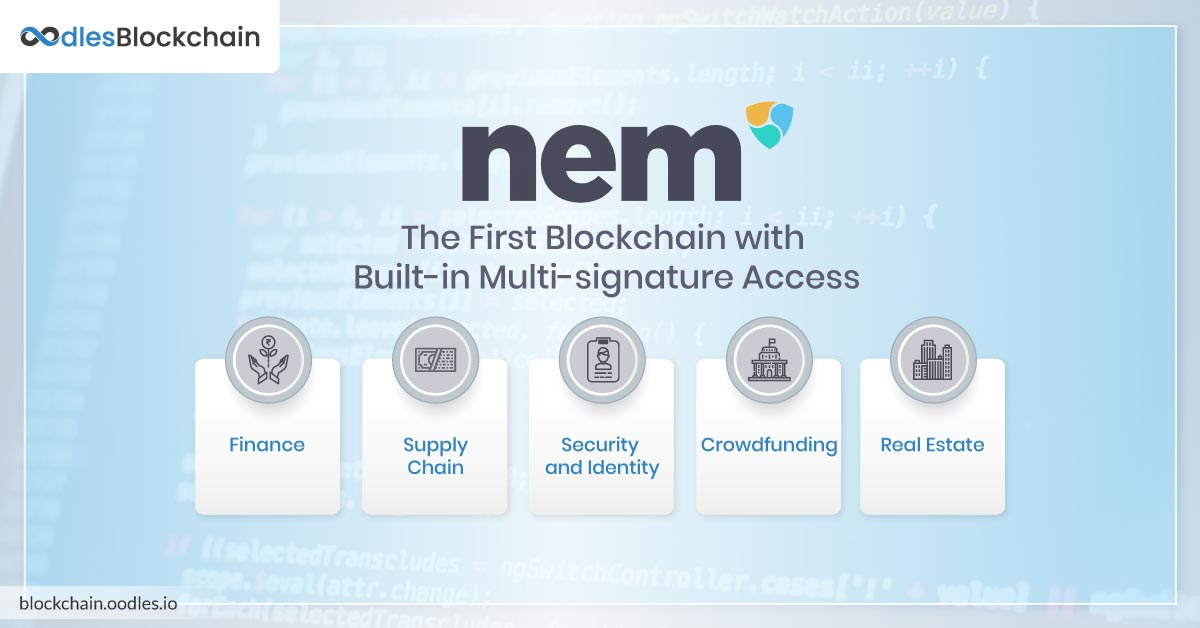-
The blockchain and cryptocurrency space is abuzz with rapid developments with new platforms and new currencies cropping up frequently. That being said, there are only a handful of platforms that developers and businesses rely on to create blockchain solutions. NEM is one such platform with a currency that has appreciated in value over the past few weeks. Although NEM development involves complexities, they are outweighed by the benefits it provides.
Understanding NEM
NEM, also known as the new economic movement, includes some of the best features of blockchains like Ethereum, and Ripple. The platform promises several efficiencies over other blockchain alternatives. It is a unique platform for developing banking solutions suitable for all financial processes. Interestingly, apart from the financial services industry, NEM has applications in logistics tracking, ICOs, document notarization, and decentralized authentication. The popularity and prevalence of NEM are attributed to its technical features.
Technical Features
Proof-of-Importance:
The algorithm used in NEM is Proof-of-Importance, which shares many similarities with methods like PoW (Proof-of-Work), PoS (Proof of Stake), and Google's PageRank. This algorithm is used to timestamp transactions. In NEM's consensus mechanism, the number of coins a user owns and the transaction he/she has made determine the importance of a user. It involves a novel algorithmic mechanism design that encourages users to make more transactions without hoarding NEM coins.
Harvesting:
It is an alternative to mining. The NEM team has designed the harvesting system to sustain the creation of XEM coins, and maintain the integrity of NEM blockchain. If someone conducts a transaction, the first node to address and validate it will notify other nearby users and form a cascade of information. The process is known as “creating a block”. The block will store all records and transactions, similar to other blockchain ledgers.
Traceable:
Although there have been issues with private transactions on blockchain platforms like Monero, NEM provides a different solution to this situation. It makes all transactions on its network traceable. While it may seem like a disadvantage, it is an added benefit that protects buyers and sellers.
Catapult: NEM Blockchain Engine
Catapult engine is a key update coded from scratch in C++ language. As mentioned on NEM's website, Catapult can significantly enhance blockchain capabilities to provide applications with greater speed and scalability. NEM's development team states that Catapult's functionalities do not feature in any existing blockchains. Catapult, also known as Mijin v.2, enables unique capabilities by using smart contract applications. In particular, users can create secure digital assets and decentralized swaps. Catapult also provides an implementation of the expanded accounting system. It lays the foundation to perform aggregated transactions and execute an advanced business logic modeling system. Using another Catapult feature, users can create multi-level accounts with multi-signature. Additionally, it also enables the implementation of diverse business algorithms by adding the logic of Yes / No, also known as “nested signatures.”
Aggregated Transactions
Aggregated transactions use several transactions and combine them into one. It creates opportunities for trustless decentralized swaps, automatic cross-chain transactions, and other advanced algorithms. Catapult generates a one-time smart contract to realize these opportunities. The contract executes all transaction components simultaneously when transacting parties approve. According to NEM developers, this functionality is currently implemented only in Catapult.
Account Recovery
Another feature of Catapult is that it enables users to restore their accounts by using multi-signatures of pre-defined third-party accounts (for instance, related to family or friends).
Production and Supply Chain
Apart from regular payment solutions, it serves as a platform for digital information exchange, which includes reports, certificates, and so on. For instance, Catapult-based multi-level, multi-sig accounts can be integrated with automated production equipment and product delivery scanners. So, when a pharmaceutical manufacturer ships products, the transactions get a quality certificate only if the following entries exist in the blockchain:
- Date of manufacture
- Security check details
- Goods delivery details including adherence to storage temperature requirements
Public and Private Networks on NEM
In reality, there are two NEM blockchains in existence. One is the private permissioned ledger, and there is also an open public blockchain at the users' disposal. Both blockchains are interwoven in a way that does not compromise on the stability or throughput of either ecosystem. More specifically, both blockchains can interact with one another without any problems. It enables businesses to develop real-world applications and smart asset systems. Gaining access to both private and public blockchain technology with minimal development is significantly beneficial for different industries. Anyone can use the public NEM blockchain with API calls. However, for applications that require more privacy, a private version of the NEM blockchain is a better solution. These trusted, private node networks can be used to power anything from loyalty points programs to shipping fleet logistics. It can be done without ever exposing the transaction data to provide speed and security. It is advantageous for organizations that want to use blockchain to scale their existing internal tools, without requiring public blockchain capabilities
Conclusion
All these features and technology innovation are the driving force behind NEM blockchain development that opens up a diverse range of use cases for various fields. We will explain this in our next blog post. Indeed, NEM offers an innovative system to become a key player in the coming blockchain-powered economy. Above all, the ease of development, flexibility, and unique PoI system make NEM a developer-friendly platform for any company looking to develop public or private blockchain solutions.

Our Offices
INDIA
Emaar Digital Greens, Sector 61,
Gurugram, Haryana
122011.
Welldone Tech Park,
Sector 48, Sohna road,
Gurugram, Haryana
122018.














